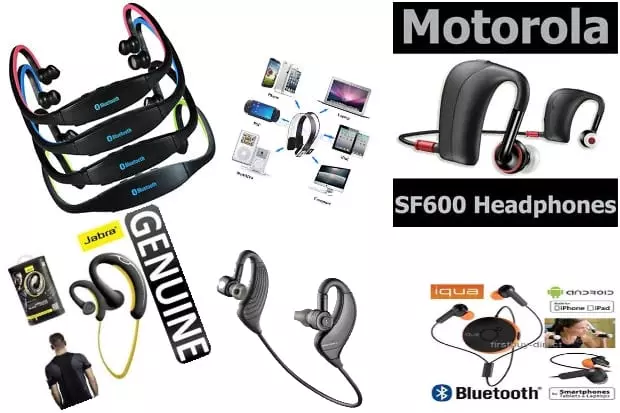There are many different types of wireless headsets/headphones to choose from but they are far from equal, and more so, certain traits make some designs/brands better than others. In this short article, I’ll be giving my advice for choosing the best wireless headset for strenuous exercise, like running, based on almost 30 years of my own fitness experience and training with music in my ears.
New designs and upgraded models of wireless headsets are coming out all the time. Choosing the best wireless sports headphones/headsets can be a real challenge for a person seriously into their fitness and who loves music but also wants the freedom of no cords. It’s not just the money that could be wasted on a poor choice of headset – it can also mean a less enjoyable workout and even a drop in performance or fitness.

Wireless music during exercise (particularly running) is a subject dear to my heart and I’d go as far to say I can’t go for a jog without listening to music along the way – that’s how important it is to me.
I’ve written a few other articles/reviews already on wireless headphones but rather than review a particular product I want to express what I know works and what doesn’t in a set of wireless headphones with some points being applicable to wired headsets also.
Of course, when I first started jogging there wasn’t any such thing as wireless so a corded headset was all anyone could get but I always struggled with them myself. Cords would get tangled, or weren’t long enough, they were easy to hit with a swinging arm and pull out, and I’d go through several headphone sets a year because of the earpieces rusting out due to sweat.
However, these days wireless technology is well established and it’s pretty easy to find a wireless headset but as stated earlier the challenge is finding a set that actually work because as frustrating as wired headphones might be, there’s no point trading them in for an expensive set of wireless headphones that constantly drop out, fall off, sound awful, and break after a few weeks of use.
10 Tips for choosing wireless sports headsets
Therefore, I’ve decided to share my 10 most relevant tips (in no particular order except for the first one #1) for choosing the best wireless headset for running or sports and they are:
- Stay away from soft plastic/silicon dome earpieces – If I was only allowed to give one tip about choosing a headset either wireless or wired this would be it… Soft plastic or silicon dome earpieces might be acoustically great for sitting on the train listening to tunes whilst commuting to work but they’re no good for workouts. Many high profile brand name wireless sports headsets come with a soft plastic dome earpiece design. Yes they are easily interchangeable, suit all sized ears, and give a nice snug fit but they are total rubbish for jogging or sports! For a start, the plastic domes rub in the ear canal and make an annoying noise each time your foot strikes the ground and jolts your body. This only gets worse the further into your workout when the sweat starts to wet these stupid bubble earpieces making them “squeak” and fill up with perspiration. At best you have to put the volume up loud to negate the ear bud noise and at worse (more likely) the headphones performance will drive you nuts and probably fail within weeks or months. That leaves us with two other choices of earpieces: solid plastic/rubber; or foam covers, both of which are also interchangeable and come in different sizes to suit different ears.
- Must be sweat proof – This applies to wired headsets also and it’s mandatory for the serious runner. Product claims that it’s “sports” or “for exercise” is not worth the box it’s written on so ensure the feature set clearly states the headset is guaranteed sweat proof (preferably to military standards). Treat any manufacturers claim stating their headset is sweat proof as a complete lie if the product has dome earpieces (see tip #1). Some good wired headsets which are sold as guaranteed sweat proof can cost more than wireless.
- Battery life – When it comes to battery life and wireless headphones you must read the specs and ensure the stated battery time whilst in use (not standby) is at least twice the length of your average workout. There’s nothing worse than your wireless headset running out of juice halfway through training and battery technology has not improved enough yet to pack many hours of battery life into a small space such as a lightweight set of headphones. A fair playback time for a headset at the moment is about 4.5 hours and anything more than that is very good.
- Get the fit suitable for you – Clip-on’s, around the ears, or over the ears are the most common ways of fitting/wearing wireless headsets. All these types can be effective in keeping your ear buds firmly secured on your ears through a strenuous workout session. I tend to lean towards the around your ears types but you may prefer ones which clip onto the ear, use a special insert to stay in the ear, or use a halo type band and fit over the ears. Where possible I advise to try them on and even wear them for an extended period to find out which type of fit you really do prefer before spending good money on a wireless headset that is uncomfortable.
- Bands – There are three types of bands connecting both earpieces, which can be purchased depending on the brand of headset chosen and they are: solid, cord, and halo. The solid plastic or rubber type usually sit behind the head or sometimes under the chin and can be a little difficult to fit although I’ve never had a problem with them. The flexible cord or thin strap types also usually go around the back and rests on the back of the neck but some can be worn under the chin. I’ve found the short cord a little annoying sticking to the back of my neck but still quite comfortable. The halo headset is probably the most secure but also the most unusual with the thin band coming over the top of the head (like standard headphones) but being secure can possibly also mean more pressure on the ears after prolonged wearing causing discomfort.
- Always carry a backup headset – Buying a set of wireless sports headphones doesn’t necessarily mean the end of wired because it’s a good idea to always keep a spare set of wired headphones just in case. I like to carry a spare headset whenever I workout because I don’t like starting my fitness session with tunes and finishing with silence due to my wireless headset inadvertently running out of power, or developing some fault. No matter how good the battery life is in my wireless headset, human frailty means I’ll sometimes forget to recharge them and they’ll run out of power half way through a session… my bad.
- Warranty – Firstly, you should understand any wireless headset used for running or high intensity activity, even if made specifically for it, will not last as long as a trusty wired headset which is used for listening to music on the lounge suite. Nevertheless, you should expect at least 12 months manufactures warranty from date of purchase. It’s very important the receipt is kept in a safe place and you buy from a retailer you can trust so if the headset does fail they can be returned and replaced. Wireless headsets (particularly the sports varieties) are notoriously prone to die and if they are from a poor batch they will usually fail within the warranty period so you'll want to return them fuss free for a refund or replacement. I've had wireless sports headsets fail within weeks and also had some which have lasted me years.
- Read reviews by runners and athletes – Forget about the standard nerds review at CNET focusing on sound and comparing the latest wireless headset to a pair of Dr Dre’s because he/she probably last went for a run in physical education class at primary school. Read reviews from other runners and athletes who have actually worn and tested a particular type of headset you’re interested in buying. Find reviews about wireless sports headsets on sports websites like running forums or fitness blogs. Look for quality reviews focused on connectivity, durability, warranty, fit, and comfort.
- Lower your playback sound expectations – Speaking about sound, if you’re looking for a magic blow your mind sound experience out of your sports headset then best you be prepared for disappointment. Sure, the music still needs to be good to listen to but if you’re demanding fantastic sound then the wireless sports headset you’re after has not been invented yet. Plus, I would question your priorities; after all, you should be concentrating on your workout with music as a background motivator rather than analysing Beethoven for your next piano lesson. To the untrained ear (like mine) most modern wireless headsets sound great anyway.
- Use a wireless headset that has a good range and with a quality device – It’s no use having the best wireless headset if the phone or music player is poor quality and the paired connection between the two keeps dropping out. You want a device that has up to date wireless technology and the software to connect to your headset without any dramas. Most wireless headsets these days have a pretty good wireless range but if the instructions state (must be worn on left side upper arm for best connectivity) then beware because it means the product has connectivity issues. Buy a headset with a reasonable range (about 10 metres) because even though your music device will likely be on your person when you’re training a good connection range means the headset will have the power to reach and say paired wherever on the person it is, such as, in hand, in a pocket, in a backpack, armband, pushbike bracket, etc.
Some useful links
Australia – Wireless sports headsets – eBay
USA – Wireless sports headsets – eBay || Sports headphones Amazon
UK – Wireless sports headsets – eBay
Conclusion
And that’s my top 10 most important tips for considering before buying a wireless headset designed for high intensity exercise or sports. Notice I didn’t mention several points like: operation of the headset (buttons etc); price; or fashion, because I don’t think they are as important as the 10 other areas covered above.
If you’d like to chat more about wireless headsets you can leave a comment below or join our forum and strike up a conversation in our fitness section – we’d love to see you there!
Mark Valencia – Editor SSM
Respect your body and keep it healthy through regular exercise…























